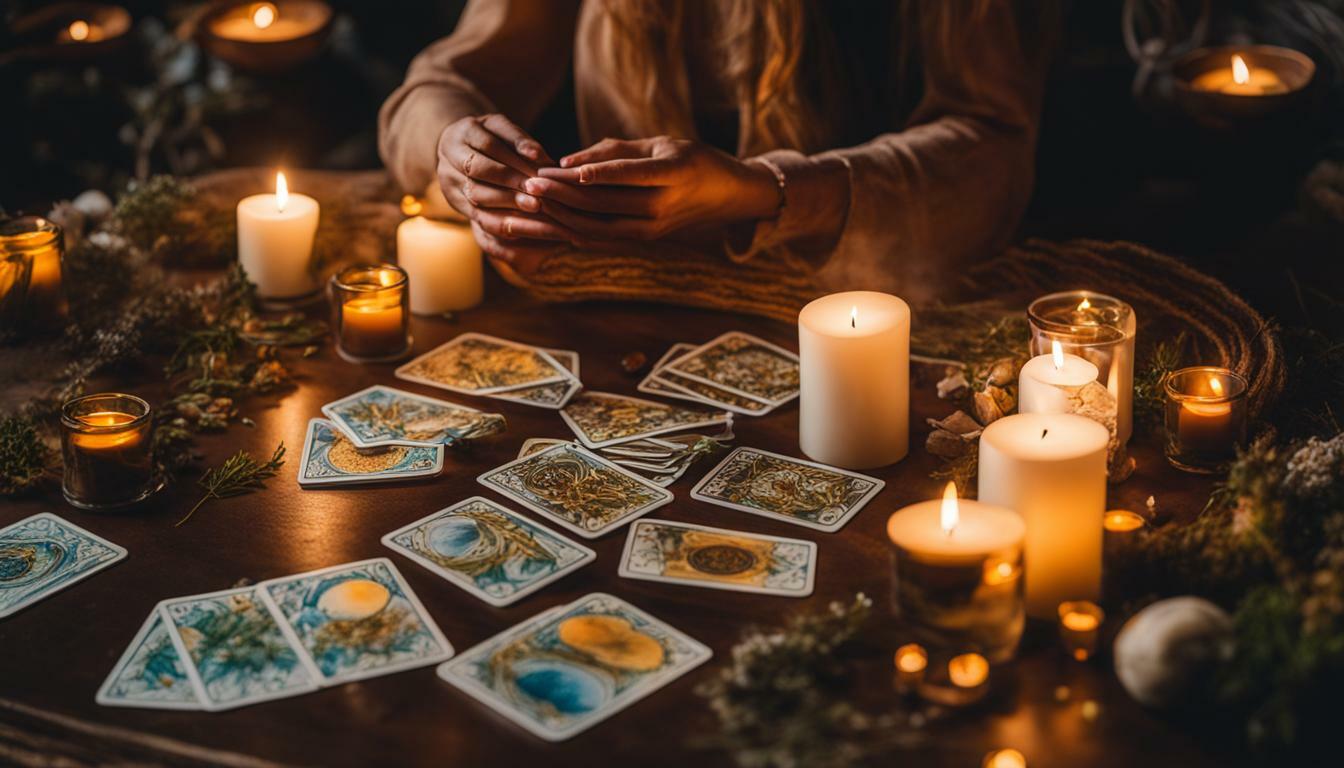Tarot cards can be a powerful tool for self-exploration and gaining insights, but it’s important to use them safely and responsibly. Tarot is not about summoning spirits or predicting the future, but rather a means of tapping into your own intuition and understanding. By following a few precautions and adopting safe practices, you can ensure a positive and beneficial tarot card reading experience.
Key Takeaways:
- Use tarot cards as a tool for self-exploration and gaining insight, rather than for predicting the future or summoning spirits.
- Prior to a reading, cleanse and protect yourself energetically to maintain a clear and unbiased energy during the reading.
- Set clear and positive intentions before each reading to guide your experience and align your energy.
- Remember that tarot cards are not absolute truths; your interpretation and intuition play a significant role in understanding the cards’ meanings.
- Choose a tarot deck that resonates with you and captures your personal aesthetics to enhance your connection with the cards.
By incorporating these safety measures, you can ensure a safe and enriching experience with tarot cards. Remember, tarot reading is a personal journey, and using these practices will help you make the most of this powerful tool for self-discovery.
Understanding Tarot as a Tool for Self-Exploration
Tarot cards are not meant to summon spirits or predict the future, but rather to help you gain insights into your own thoughts, emotions, and experiences. They serve as a mirror, reflecting back what you may already know deep down but may not be fully aware of. It’s important to approach tarot with an open mind and a willingness to explore the depths of your inner being.
“Tarot cards are a powerful tool for self-reflection and personal growth. They allow you to tap into your subconscious mind and explore the hidden aspects of your psyche. Through tarot, you can gain a deeper understanding of yourself, your relationships, and the world around you.”
When using tarot cards for self-exploration, it’s essential to take certain precautions to ensure a safe and enriching experience. Begin by creating a calm and sacred space for your readings. You can set the mood by lighting candles, playing soothing music, or incorporating crystals and incense if you’re drawn to them. This helps to create an atmosphere conducive to introspection and connection with your higher self.
Remember that tarot cards are simply a tool, and their true power lies in your interpretation and intuition. Each card holds multiple layers of meaning, and it’s up to you to unravel their significance in relation to your own life. Trust your instincts and allow your intuition to guide you as you explore the messages and symbols presented by the cards. As the saying goes, “The cards speak to those who listen.”
Safe Practices for Tarot Card Readings
Here are some safe practices to keep in mind when using tarot cards:
- Use clean and energetically charged cards: Before each reading, take a moment to energetically cleanse your tarot deck. You can do this by gently shuffling the cards, holding them under running water, or placing them in a satchel of dried herbs or crystals overnight. This helps to remove any residual energy from previous readings and ensures a fresh start.
- Ground and protect yourself: Prior to each reading, take a few moments to ground yourself by connecting with the Earth. Visualize roots growing from the soles of your feet, anchoring you to the ground. Additionally, imagine a protective shield of white light surrounding you, shielding you from any negative energies that may be present.
- Set clear intentions: Before you begin a reading, take a moment to set clear intentions. Ask yourself what you hope to gain from this reading and what areas of your life you would like to explore. Setting intentions helps to focus your energy and ensure a meaningful and insightful reading.
- Keep a tarot journal: Consider keeping a tarot journal to record your readings, insights, and reflections. This allows you to track patterns, notice recurring themes, and keep a record of your personal growth and development over time.
| Safe Practices for Tarot Card Readings | |
|---|---|
| Use clean and energetically charged cards | – |
| Ground and protect yourself | – |
| Set clear intentions | – |
| Keep a tarot journal | – |
By following these safe practices and approaching tarot with respect and mindfulness, you can create a meaningful and transformative experience. Remember, tarot is a tool for self-exploration and personal growth, offering insight, guidance, and a deeper understanding of yourself and your journey.
Energetic Cleansing and Protection Before a Reading
Before starting a tarot card reading, it’s crucial to cleanse and protect yourself energetically to ensure a safe and accurate reading. Tarot cards are not about summoning spirits or predicting the future, but rather a tool for self-exploration and gaining insight. By following these tarot card usage precautions, you can create a positive and sacred space for your readings.
One of the first steps in preparing for a tarot reading is to cleanse yourself energetically. This can be done through activities like taking a relaxing bath, meditating, or engaging in physical exercise to release any negative energy you may be carrying. By clearing your mind and grounding yourself, you create a receptive state for receiving guidance and intuitive messages during your tarot reading.
In addition to cleansing yourself, it’s also important to cleanse your tarot deck. This can be done through various methods, such as shuffling the cards thoroughly or using crystals and sage. Cleansing the deck helps to clear any residual energies from previous readings and ensures that you are working with a clean and neutral energy field. It’s advisable to set aside some time before each reading to focus on cleansing the deck and connecting with its energy.
Remember, tarot cards are not the ultimate truth, but rather a reflection of your own intuition and interpretation. It’s essential to approach each reading with clear and positive intentions. By setting intentions, you determine the energy you put out and the experience you will have. Take a moment to center yourself, visualize the outcome you desire, and ask the cards for guidance and insight. Your intentions will help to create a sacred space for your readings and enhance the accuracy of the messages you receive.
In summary, ensuring safety while using tarot cards involves energetically cleansing and protecting yourself, as well as setting clear intentions. By creating a sacred space and approaching the cards with respect, you can experience the full benefits of tarot as a tool for self-exploration and personal growth. Choose a deck that resonates with you, keep a tarot journal to track patterns and themes, and remember to regularly cleanse and reset your cards to maintain their energy. With these precautions in mind, you can embark on a journey of self-discovery and gain valuable insights through your tarot card readings.
| Tarot Card Usage Precautions: |
|---|
| 1. Cleanse yourself energetically before a reading through activities like taking a bath, meditating, or exercising. |
| 2. Cleanse your tarot deck by shuffling the cards or using crystals and sage. |
| 3. Set clear and positive intentions before each reading to create a sacred space. |
| 4. Remember that tarot cards are not the ultimate truth, but a reflection of your own intuition and interpretation. |
| 5. Choose a tarot deck that resonates with you and keep a tarot journal to track patterns and themes. |
| 6. Regularly cleanse and reset your tarot cards to maintain their energy and accuracy. |
Setting Clear Intentions and Understanding Interpretation
Setting clear intentions before a tarot reading helps to determine the energy you put out and the experience you will have, while interpretation relies on your own intuition and understanding. When sitting down for a reading, take a moment to center yourself and focus on what you hope to gain from the experience. Whether it’s seeking guidance on a specific situation or simply looking for general insight, having a clear intention will help you establish a connection with the cards.
Remember, tarot cards are a tool for self-exploration and reflection. They should not be seen as absolute predictions or sources of concrete answers.
During the reading, trust your intuition and allow the cards to speak to you. Each card carries its own symbolism and meaning, but it’s important to interpret them in the context of your own life. Listen to the guidance that resonates with you and trust your instincts. Using your own understanding of the cards, you can weave together a narrative that speaks to your unique circumstances.
As with any form of divination, interpretation is a personal process. It’s highly recommended to keep a tarot journal to record your readings and thoughts. This not only helps you track patterns and themes that arise but also allows you to reflect on your interpretations over time. You may notice that certain cards appear frequently or that specific combinations hold deeper meaning for you. Your journal can become a valuable resource as you deepen your relationship with the cards and develop your own personal interpretations.
| Tips for Safe Tarot Card Interpretation: |
|---|
| Focus on positive energy: Be mindful of the energy you bring into the reading and aim to maintain a positive mindset. This helps create a conducive environment for accurate and insightful interpretations. |
| Trust your intuition: While tarot cards have traditional meanings, it’s crucial to trust your instincts and allow your intuition to guide your interpretations. Your unique perspective adds depth and meaning to the cards. |
| Practice self-reflection: Take the time to reflect on your interpretations, both during and after the reading. Consider how the cards relate to your current situation and what lessons or insights they may offer. |
| Embrace ambiguity: Tarot cards often offer guidance in symbolic and metaphorical ways. Embrace the ambiguity of the cards and allow their messages to unfold organically, rather than seeking definitive answers. |
By setting clear intentions and trusting your intuition, you can unlock the true power of tarot cards as a tool for self-exploration and personal growth. Remember, the cards are a reflection of your own energy and understanding. Embrace the journey and let the cards guide you on a path of self-discovery.
Choosing an Appropriate Tarot Deck and Keeping a Tarot Journal
Selecting a tarot deck that speaks to your personal aesthetics and energies is important for a meaningful and safe reading. Tarot decks come in various themes and artistic styles, so you can find one that resonates with you and enhances your intuitive connection. Whether you prefer classic tarot imagery or more modern interpretations, finding a deck that visually appeals to you can enhance your overall experience.
When choosing a tarot deck, consider the symbolism used, the colors, and the overall energy it emits. Some decks may focus more on love and relationships, while others may delve into the realms of spirituality or personal growth. By understanding the theme and energy of the deck, you can select one that aligns with your intentions and desired outcomes.
In addition to selecting the right deck, keeping a tarot journal can greatly enhance your tarot practice. A tarot journal is a valuable tool for tracking your progress and gaining deeper insights into your readings. In your journal, you can record the cards drawn, the date, and any significant thoughts or observations that arise during your readings. By documenting your experiences, you can begin to notice patterns and themes that may emerge over time, allowing you to develop a deeper understanding of the cards and their meanings.
Consider using a table format in your tarot journal to organize your readings. Create columns for the date, card names, and your interpretations or reflections. This can help you easily reference past readings and compare the cards and their meanings in different contexts. By consistently using a tarot journal, you can enhance your connection with the cards and gain a greater understanding of their messages.
| Date | Card Names | Interpretations/Reflections |
|---|---|---|
| February 1st, 2022 | The Fool, The Magician, The High Priestess | Embarking on a new journey, harnessing personal power, tapping into intuition |
| February 8th, 2022 | The Lovers, The Hermit, The Chariot | Exploring relationships, seeking inner guidance, taking control of one’s path |
| February 15th, 2022 | The Empress, The Emperor, The Hierophant | Nurturing creativity, embracing leadership qualities, seeking spiritual guidance |
Maintaining the Energy of Your Tarot Cards
To ensure the accuracy and effectiveness of your tarot card readings, it’s important to establish a designated ritual to cleanse and reset your cards between readings. By maintaining the energy of your tarot deck, you create a clear and unbiased channel for receiving intuitive guidance.
One method of cleansing your tarot cards is through shuffling. This can be done by thoroughly shuffling the deck, allowing the cards to be mixed and releasing any lingering energy from previous readings. Additionally, you may choose to use crystals or burn sage to cleanse the deck. Simply pass each card through the smoke of the burning sage or place a cleansing crystal, such as clear quartz, on top of the deck overnight.
Resetting the energy of your tarot cards can be done by placing them back in their designated storage space after each reading. This helps to maintain the integrity and effectiveness of the deck. It’s also beneficial to establish a personal connection with your cards by holding them in your hands, setting an intention for the upcoming reading, and visualizing a clear and positive energy surrounding them.
| Methods for Cleansing Tarot Cards | Methods for Resetting Tarot Cards |
|---|---|
|
|
By incorporating these practices into your tarot card reading routine, you ensure that your readings are conducted in a safe and energized space. Remember, your intuition and interpretation are key components of the reading, so trust yourself and allow the cards to guide you on your personal journey of self-discovery.
Are There Any Safety Precautions I Should Take When Laying Out Tarot Cards?
When laying out tarot cards, it’s important to consider safety precautions to ensure an accurate reading. First, create a sacred space by cleansing and protecting your environment. Use a soft cloth or tarot mat to avoid damage to the cards. Ground yourself and set clear intentions before shuffling the deck. Finally, trust your intuition and focus on the question at hand to effectively learn how to read tarot cards.
Conclusion
Using tarot cards can be a safe and beneficial practice when proper precautions are taken, allowing you to gain valuable insights and answers to your questions. Tarot is not about summoning spirits or predicting the future, but rather a tool for self-exploration and personal growth. One of the key precautions to keep in mind is energetically cleansing and protecting yourself before a reading. This can be done through activities such as taking a bath, meditating, or exercising, to ensure that your own negative energy doesn’t interfere with the reading. It is also important to cleanse the tarot deck itself, using methods like shuffling the cards or using crystals and sage.
Setting clear and positive intentions before a tarot reading sets the tone for the experience you will have. Remember, tarot cards are not the ultimate truth, but rather a tool for reflection and guidance. Your own interpretation and intuition play a significant role in understanding the cards and their messages for you. Therefore, choose a tarot deck that resonates with your personal aesthetic and keep a tarot journal to track patterns and themes that arise from your readings.
To maintain the energy of your tarot cards, it’s important to have a designated ritual to cleanse and reset them between readings. This can be as simple as using crystals, incense, or a tapping ritual. By regularly performing these rituals, you ensure that your tarot cards remain energetically vibrant and ready for use. Remember, tarot reading can be a regular practice that can be done at any time, and with these precautions in place, you can confidently explore the depths of your subconscious, gain insights, and find guidance.








